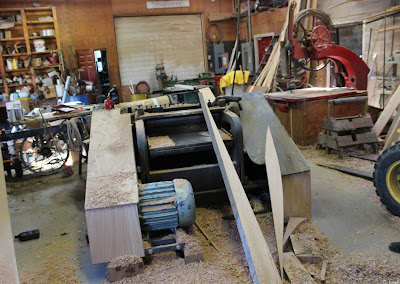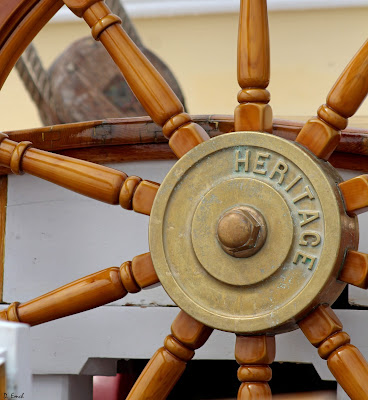Welcome to the Heritage, a coasting schooner berthed in Rockland Maine.
For many of us, the word Heritage is associated with traditions, with cultural identity - it is a word that can have a variety of deep meanings. And as we saw in the last article on Rockland, this area has a long tradition of building wooden vessels to ply the seas.
These vessels were referred to as "Wind-Jammers," Whereas "clipper" ships were built for speed, windjammers were built to maximize cargo capacity. Ferrying coal, produce, wood, limestone and other goods from port to port, these schooners were the commercial arteries for many towns on the east coast. Thus these were sturdily built craft that could maximize the power of the wind while remaining light and maneuverable enough to sail into smaller ports. They fell out of fashion with the advent of steam powered propulsion and metal hulls, and for many decades none were produced along this coast. That all changed in 1983 when this vessel was launched. It was the courage and the efforts of Doug and Linda Lee that brought it to life.
Doug and Linda met in college at Pratt where Doug was studying Mechanical Engineering and Linda was studying Fashion design. Linda had never sailed, and after Doug brought her up here for a weekend sail she fell in love with sailing - and presumably Doug as well.
They moved here in the early 1970's and decided that they would rebuild an old schooner and sail it on weekly charters. They ended up rebuilding 4 schooners and were very active helping with a 5th.
They had the vision that it was time to build a "next generation" schooner. All the ones that they rebuilt were designed to haul cargo and posed issues when it came to up-fitting them to carry passengers on extended cruises. So, they decided to build their own. Doug learned drafting and they spent the winter of 1978 - 1979 drawing plans for a new vessel.
In the process of rebuilding the 5 previous vessels, they acquired an old shipyard on the north end of the harbor that had fallen into disrepair. Overlooking it was a small house - the house of the old shipyard owner. The middle section of the house and the entire right wing of the house have been added on by Doug and Linda.
This is what the house overlooks now.
There was an old rail on the ground that had had to be rebuilt, and the little inlet required much dredging. Today the rail is capable of handling fairly large workboats that need maintenance and repairs.
As Doug drew up plans, they started acquiring tools. They rebuilt this big saw.
The advantage of that particular saw is that it allows adjustments to the blade even while the saw is in the middle of a cut. Thus, the long interior beams of a ship that require various different curvatures in the same length can be cut in one pass.
Another issue is steel and iron fittings. There are a bunch of them in a large vessel, and the fellow who had been doing their metal work retired. So, Doug bought a forge and metal working equipment and read a few books to learn the most effective techniques.
It takes a lot of equipment to build a boat and there is a lot more to the shop than these few photos. This next photo is of a huge planer - I think Doug said it has a sixty horsepower motor.
And the next thing that had to be done was to build a building to build the boat in. This would be a temporary building that would allow them to work their summers chartering on the boats they had rebuilt and spend the long, cold Maine winters building the craft they had envisioned.
Heritage brochure photo
Obviously I could spend a month writing just about all that goes into doing this and we need to keep moving. One small interesting note though are the pieces of wood used in the areas that require a short but stout piece to bear loads or brace at 90 degrees.
Doug and Linda had several local timber companies setting aside the best pieces of timber for them, but these are a special wood. The Hackmatack tree is a member of the larch family that sends its roots straight out at ground level. Thus, a good specimen can provide a very sturdy 90 degree beam.
Another thing of note is the ballast that a ship like this requires. Sails that stand up over 100 feet deliver a lot of power from the wind, but that means there is a lot of torque too. Without a deep keel underneath the vessel it would easily flip during a crosswind. But a deep keel means that there are not many ports deep enough for the vessel to enter. The solution? A bunch of weight in the belly of the boat so that its natural position is always "upright." Kinda like those old "weebles" - remember "Weebles Wobble but they don't fall down?"
So the answer for this boat is lead bars. Lots of them, all positioned right at the very bottom of the boat.
They are wedged in below decks, and there are a bunch of them 33 tons of lead resides in the bottom of this boat.
Photo by Sean Grimes
Doug and Linda were able to build in spaces that made sense for passengers - one of the most important being the galley.
The galley is the heart of a ship - and this is the only one of these Windjammers that can accommodate 30 passengers and crew at the same time.
As the day to launch the hull came closer and closer, a bit of excitement built among those that understood what this signifies. They figured a few hundred might show up - but they were way off. Three thousand folks showed up to watch this launch.
Heritage brochure photo
The town of Rockland got concerned and sent a police officer down for "crowd control." He didn't do anything but watch the launch like everyone else - but the city sent Doug and Linda a bill for the use of one of their policemen.
Four winters of construction and this is what they ended up with. (Visit their website by clicking Here.)
145 feet and 330,000 pounds of lean, muscular sailboat. Being a traditional schooner there is no engine or propellor. And because it is a large vessel, people and supplies need to be able to get to shore and back when there isn't a large commercial wharf available. So four more boats had to be built.
When steam power came along, the boat owners built little motor boats that could push the vessel in and out of ports and allow them to make a bit of distance when there was no wind to fill the sails. So the first boat to be built had to provide "muscle."
Above you see the little boat pulling the Heritage away from the dock. Ships captains took to naming these small boats after mythological giants - Zeus, Atlas and the like. But this was to be the next generation of schooner, and that required the next generation of mythological giants.
"Superman" comes to the rescue - a diesel powered boat with lots of muscle.
Even the engine cover is emblazoned with his emblem.
This boat is too heavy to hang over the side, so it hangs from a set of pulleys on the back of the boat.
And, of course Superman needs a companion. So the second boat, a rowboat designed to haul passenger, is named "Lois Lane."
Two more boats are attached along the side on arms called "davits."
These are equipped with block and tackle arrangements so that the boats can hauled up and down by hand.
The crew is preparing for another week's voyage. Everything gets scrubbed down.
All the brass and stainless steel fittings get polished.
Provisions to feed 36 people for a week are brought on board.
Large insulated chests on deck are iced down and then filled with provisions.
One of the things that the crew do for guests is to have a lobster roast during the week. So lobsters are purchased from a local fisherman.
After being selected and weighed, they are carried aboard.
Linda and Doug have invited us aboard for the week. When I first arrived at the Heritage Linda was off buying groceries. After talking with Doug for about an hour I was leaving and heading down the coast another thirty or so miles. When I stopped in the road to take a photo of the shipyard a woman in a passing van waved. I thought that must be his wife, so I returned to get a photo of both of them. After talking to them for a bit Linda said "why don't you join us this week?"
Initially I declined because I really need to make Kitty Hawk by the first of the year and am already running a bit behind. But after sleeping on it I felt really moved to go along. The thing that decided it for me was the name of the boat - "Heritage." So we are off on a week long sail on the waters of Maine.
Before the boat leaves we have a bit of time to look around - although passengers board on Sunday night the boat doesn't actually pull out of the harbor until Monday morning. Just down the wharf is a business that sells herring to lobstermen for bait. Loading a semi with herring brings a large crowd of the ever opportunistic sea gulls.
The closest neighbor gets to have a well decorated roof.
I don't think I would have picked the color black for the shingles.
So we will be off on a cruise of the coastline of Maine this week - how exciting.
It looks like we will have thirty unsuspecting souls as well as a lot of Maine coastline to turn our lens on. The coastline will slide by, but the passengers are a captive audience. How fun is this going to be?
That thought brings us to today's "Faces in the Crowd."
I don't think he likes telephoto lenses. I had a series of shots of him smiling and joking, but when he sensed a camera on him and turned his expression changed immediately.
And since we are going to be boarding ship tomorrow, we might as well brush up on boarding techniques with today's parting shot:
Click Here to contribute to this effort and click here to email me.
Make it a great day !!
David






































Thanks for wwriting
ReplyDelete